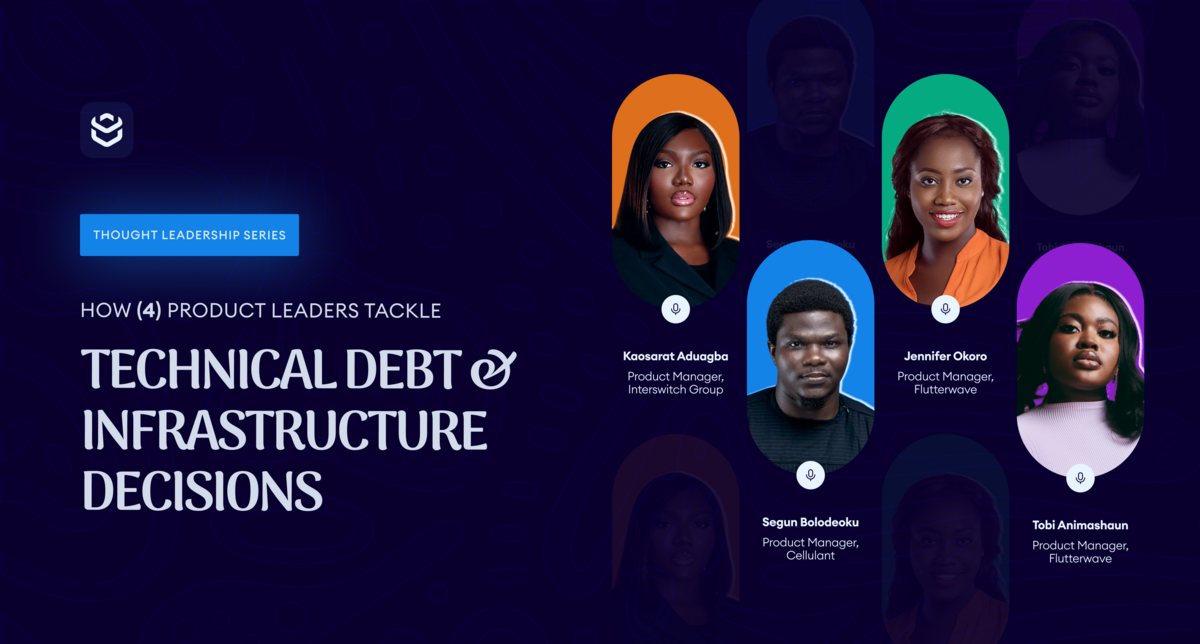Written by Omolara Racheal Olanibukun, Edited by Isioma Ogwuda
Every fintech team eventually runs into the same crossroads. Do we build our own systems or rely on a third party? Do we take on technical debt to move faster or slow down to protect stability? These decisions shape how quickly a company can scale, how much risk it can manage, and how much trust it earns from customers.
To make this piece worth every minute of your read, we’ve gathered insights from those who've been in the trenches. They shared what matters most, the trade-offs they have faced, and the smartest ways to navigate these challenges.
A special thank you to the experts who shared their time and perspectives.
- Segun Bolodeoku, Product Manager at Cellulant
- Kaosarat Aduagba, Product Manager at Interswitch Group
- Tobi Animashaun, Product Manager at Flutterwave
- Jennifer Okoro, Product Manager at Flutterwave
Build or Buy Payment Infrastructure: Key Factors to Consider
The build-versus-buy debate is one of the most defining calls for a fintech. It touches compliance, growth speed, and the ability to scale across markets. The right choice can unlock expansion. The wrong one can slow progress or even put the business at risk.
Here is how product leaders weigh the decision.
1. Compliance is not negotiable
Segun Bolodeoku:
Compliance always comes first.
Payment is one of the most regulated industries in the world.
These regulations cover a wide range of factors such as licenses, data protection, operational risks, data usage, and many more.
Compliance is an essential factor to consider when deciding whether to build or buy a payment infrastructure. It’s non-negotiable.
Kaosarat Aduagba:
Compliance is a gatekeeper, and if a solution fails there, it doesn’t move to the next stage of consideration.
A non-compliant payment infrastructure can lead to:
- Legal sanctions
- Customer distrust
- Financial penalties
- License revocation or suspension
- Reputational discredit, etc.
2. Scalability & Long-Term Flexibility:
Scalability is the second most important factor to consider when choosing to buy or build a payment system.
It’s not enough for your infrastructure to work today, it has to grow with you tomorrow.
Before you make that decision, ask yourself:
- Can this system handle heavy transaction volume during peak seasons?
- Will it support new payment methods?
- Can it adapt to regulatory changes, evolving needs, or new business models?
As Kaosarat Aduagba rightly put together:
An infrastructure designed to scale seamlessly means we can onboard new merchants, expand into new regions, or integrate emerging payment technologies like QR or contactless, without having to rebuild the foundation each time.
3. Speed to Market
Timing is everything.
While this can be easily overlooked, it plays a key role in determining whether you’re creating a product that’ll lead the market or play catch-up.
Particularly in situations where you’re expanding into a new payment channel or there’s a ‘strategic go-live date tied to a partnership or a campaign’. Time determines the success of these projects.
Kaosarat Aduagba:
While building in-house offers control, it can take considerable time to design, develop, test, and launch a payment infrastructure.
If buying a ready-made, proven solution allows us to deploy faster while still maintaining quality and compliance, it becomes a strong contender.
Segun Bolodeoku:
Startups, in particular, may lean toward buying to get to market quickly and avoid the upfront burden of building.
Is Building a Payment Stack Worth the Extra Complexities?
The decision to build or buy a payment infrastructure hinges on how central payments are to the company’s strategy.
While this isn’t a one-size-fits-all approach, it’s important to decide based on the company’s standpoint.
For businesses where payments are a core differentiator, building gives you full control and direction.
From tailoring customer experience to adapting to regulatory requirements, this agility can be a significant competitive edge.
Segun Bolodeoku:
I was closely involved with a team that had to decide whether to build or buy reconciliation infrastructure covering not just mobile money, but also banks, cards, and other alternative payment methods across multiple Sub-Saharan African markets.
Several third-party platforms offered automated reconciliation and had integrations with some providers.
However, once evaluated, it became clear they could not fully meet the business’s needs.
Handling one payment rail well was feasible, but the combination… required a level of customization that off-the-shelf tools couldn’t support without significant compromise.
The team ultimately chose to build. The deciding factor was fit and long-term scalability [But ownership comes at a cost].
Kaosarat Aduagba:
Building in-house demands more engineering resources, ongoing maintenance, and compliance management.
If an organization doesn’t have the capacity or if payments are not the differentiator, the complexity may outweigh the benefits.
In short, the ultimate decision depends on whether the payment system directly affects the company’s performance and customer experience in ways that a third-party provider can not offer. If it doesn’t, the resources may be better directed toward other priorities that drive growth.
Jennifer Okoro:
It is best practice to leverage a third-party payment service provider at the early stage of the start-up, and then consider building in-house as the product scales.
If You’re a Startup Deciding Between Build vs. Buy, Read This First
Deciding between buying and building a payment system goes beyond surface-level analytics.
Go too slow, and you miss the market.
Go too fast, and you risk breaking under pressure.
So what’s the best path? Segun explains the importance of optimizing for every stage.
“Optimize for the stage you’re in, but plan for the stage you want to reach.”
Segun Bolodeoku
On a similar note, make sure to;
“Buy to move fast, then build to optimize.”
Jennifer Okoro
However, Kaosarat emphasizes on the importance of clearly defining payments:
“Be crystal clear on your why. Clearly define whether payments are core to your competitive advantage or simply a supporting function.”
Kaosarat Aduagba
Is Technical Debt Always a Risk or a Smart Growth Hack?
Technical debt often sparks concerns.
Why?
It’s often seen as a high-interest loan that will bite harder tomorrow.
However, technical debt is not always negative.
Tobi Animashaun:
Intentional technical debt can be the right move if it allows you to launch quickly, capture demand, or prove value to customers.[But here’s the catch: not all debt is created equal].
Technical debts can not be tolerated in certain areas, such as:
- Core Transaction Processing
- Settlements & Reconciliation Systems
- Security & Data Protection
- Risk & Fraud Management
- Customer Trust Touchpoints
However, debts can be more acceptable in non-transactional areas such as:
- Reporting Dashboards
- Back-Office & Operational Tools
- Secondary User Experience Features
- Non-Critical Integrations; for example, delaying deep CRM integration in favor of a faster manual workaround.
- Internal Knowledge Management
Tobi Animashaun:
The key is to make trade-offs consciously, be transparent with the team about the risks, and ensure there is a defined timeline for resolution.
Avoiding all debt can slow growth, but ignoring critical debt in core systems can be catastrophic.
The goal is to balance short-term market wins with a plan for long-term stability.
How Much Technical Debt Can You Really Afford?
The answer isn’t one-size-fits-all.
This depends on the company’s strength, market timing, infrastructure, and product risk profile.
Tobi Animashaun offers a sharp perspective on how much technical debt startups can realistically take on:
The stakes are higher. Focus on shipping features that can be improved later rather than locking in costly architectural debt too early.
[But for enterprises]. Larger teams and established processes make it easier to manage both revenue-driving work and debt repayment.
The challenge is prioritization and making sure debt does not get buried in a backlog.
Final Thoughts
Making the hardest decision in a fintech company requires knowing the right information.
Whether you’re taking on technical debts or choosing between building or buying payment infrastructure, every decision has consequences.
The best choice is understanding what works for you, and moving towards the goal.
Found in:
Marketing



